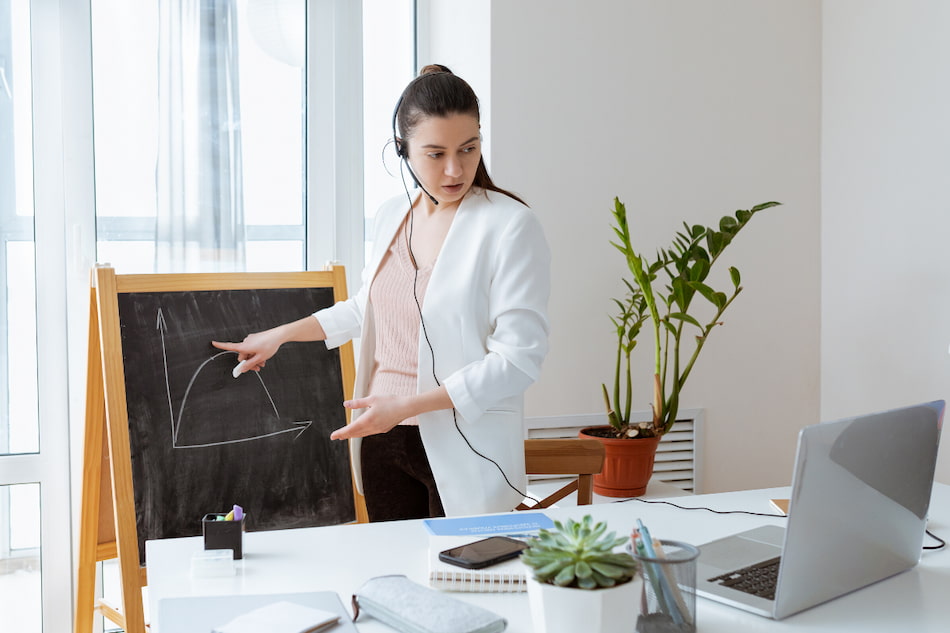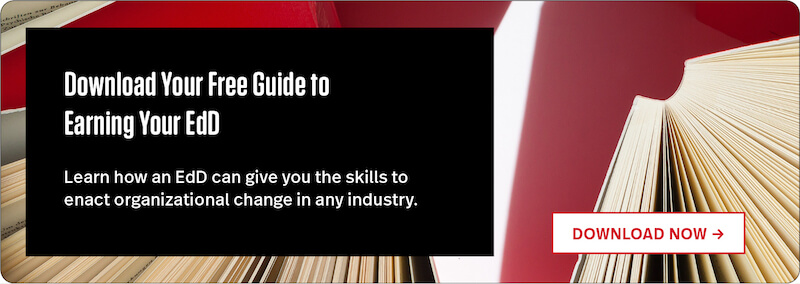The emergence of the novel coronavirus (COVID-19) in late 2019, and its subsequent development into a global pandemic, has had a profound impact on nearly every aspect of American life.
In an effort to flatten the curve of infection and prevent healthcare systems from becoming overwhelmed, most of the nation has entered a period of lockdown and social distancing—a practice in which individuals limit their physical contact with others.
Many businesses have had to convert to remote work or have ceased operating altogether; the healthcare system has had to address major public health issues, such as disparities in healthcare access, food insecurity, and the effects of isolation; and schools and universities have been forced to embrace remote learning in order to simultaneously educate and protect their students.
The impacts on business and public health have received the bulk of media examination, but the pandemic’s effects on the education sector should not be overlooked. Since the onset of the pandemic, educators throughout the country and across all grade levels have played an important role in maintaining the physical and emotional well-being of their students—often simply by asking themselves: How can I make a difference?
Below, we explore the impact that COVID-19 has had on the world of education and how Northeastern students and faculty members have been able to make a difference in their communities.
Download Our Free Guide to Earning Your EdD
Learn how an EdD can give you the skills to enact organizational change in any industry.
The Impact of COVID-19 on Education
The sudden shift to distance learning and remote education has already caused significant challenges for educators who now find themselves in uncharted waters.
One key area of concern has been equity in education. Though more affluent school districts and students have been able to shift to remote learning with relative ease, children living in underserved communities have had more difficulty doing so. Remote learning, after all, relies on a fast and reliable internet connection—which for some families is a luxury that can’t be afforded. As a point of reference, consider the fact that 21.3 million Americans did not have access to broadband during 2019, according to the Federal Communications Committee (FCC). How do we prevent at-risk students from “falling through the cracks”—cracks which have admittedly grown wider due to the pandemic?
It is also important to note that teachers perform more roles than teaching. Educators are also often the first line of defense against abuse, identifying potential areas of concern and reporting them to authorities who can ensure a child’s safety at home. Due to remote learning, it is more difficult for teachers to identify instances of abuse, even as they have been on the rise as lockdown has forced children to spend longer periods of time in a confined space with their abusers.
And then, of course, is the challenge of offering the predictability and structure that most students—particularly our special needs students—require, while also remaining flexible enough to deal with the unknowns of our current reality.
Other questions exist as well:
- How do we ensure that a student’s social and emotional wellbeing is preserved during this crisis, even though we are not physically close to them as we would be in the classroom?
- How do we track all of the issues that faculty may be seeing and encountering in a virtual setting?
- What do we do about graduation and commencement ceremonies?
- In a college setting, how do we find housing for international students who are now potentially stranded in the U.S. with no dormitories?
- How do we memorialize those people who are no longer with us?
- What are the best technologies for us to leverage to meet all of these goals?
While these questions are unique and specific, they are all focused on ensuring the same general outcome: That students emerge from this challenge healthy, happy, and without any long-lasting trauma.
Karen Reiss Medwed, associate teaching professor and the Assistant Dean of Academic and Faculty Affairs in the Graduate School of Education, says, “It’s about answering the questions: What does it take to be connected online? What does it mean to be relational? How can we be present for these students in a time in which they need to feel safe, secure, and loved?”
Unfortunately, there is no single answer that will apply in all situations or circumstances; educators will need to rely on their own education, experiences, and relationships with students to craft solutions and strategies that fit the unique needs of their communities.
Despite the uniqueness of each educator’s circumstances, the lessons below, from Northeastern University faculty and Doctor of Education (EdD) students, can serve as inspiration.
How Educators Can Make a Difference
One way that educators can work to address these concerns is to pursue an advanced degree, such as a Doctor of Education (EdD), which will prepare them with the skills that will be needed to implement change on both the administrative and policy levels while also focusing on key issues of social justice.
“Students come into our program seeking to be change agents,” Reiss Medwed says. “At Northeastern, social justice is a part of our explicit mission. We know that we’re very lucky to be in touch with many students whose orientation to the world is to try and make the world a better place.”
Reiss Medwed proudly notes that there are countless examples of Northeastern students and faculty who are already making a difference during the pandemic.
“It’s really no surprise that they’re stepping up and stepping in during moments like these,” she says. “One of the first things we saw when all of this began was students reaching out to faculty and saying, ‘Can I think through with you about these various challenges?’ These are students who are also parents and who are also classroom teachers, who are all trying to figure out: What are we going to do with all of these kids to make sure that they’re okay and that they’re not traumatized?”
Below we explore how a few students and faculty members have been able to apply their classroom experiences to address some of the questions educators are facing daily during the pandemic.
How can we use technology in education during COVID-19?
Sarah Kyriazis, who manages instructional technology and digital learning for the Worcester Public School System, is leveraging the experiences and skills that she gained in Northeastern’s EdD program to support her district’s move to a digital space. “She’s taking what she’s learning with us in her classes and now she’s trying to figure out how to do this with everyone else,” says Reiss Medwed. One way Kyriazis is accomplishing this is through the creation of instructional videos for families in a variety of languages.
How can we lessen the gap created by distance-learning?
Natasha Noren, another student in Northeastern’s EdD program, works as a technology specialist for her school. Though her institution has the resources and expertise to leverage various tools for their distance learning initiatives, many of the public schools in her area do not. As such, she is actively working to find ways to provide equitable access to these resources during the pandemic.
“Our students come to us with a sense of responsibility to their communities,” says Lydia Young, Director of NExT. “By understanding how they want to make an impact, our faculty is able to dig in deeper with them to make it a reality.”
Some of the other challenges that Northeastern EdD students and graduates are addressing at their institutions include:
- Ensuring that educators are still capable of caring for special needs students, who are often accustomed to receiving more tailored, in-person, one-on-one support
- Establishing the tracking and monitoring mechanisms educators need to ensure effective virtual learning, and ensuring that low-performing students have the subsequential support that they need to succeed.
- Ensuring that the general emotional well-being of students is being preserved despite the trauma of sudden social distancing
- Handling the disparity between the closure lengths at the state and school-levels
- Dealing with the repercussions of canceled SAT/ACT testing for the spring
- Transitioning AP testing to a fully online format for high schoolers
- Addressing the lack of access to technology for students and teachers alike
Preparing to Make a Difference
Even after the threat of the coronavirus pandemic is brought under control and distance learning ends, the same underlying challenges faced during the pandemic are likely to still exist—whether or not students are physically in the classroom.
There will be underserved communities. There will be children who do not have the same resources made available to children of affluent families. There will be neglect and disparities. But without the focus of webcams and Zoom classrooms, they are all too likely to fade from the public conscience.
The risk, of course, is that any progress made towards improving equity in the classroom during the pandemic will be lost to inaction after the crisis ends. Long-lasting change and success will be dependent upon educators, administrators, and policymakers who are compelled to make a difference—who personally refuse to concede that the battle is lost.
For those individuals, earning an EdD with an emphasis on social justice and educational equity is an excellent means of gaining the knowledge, experience, and expertise that will be required to usher through these major changes.
“As far as the immediate challenge of distance learning during COVID-19, I think the fact that our program is entirely online has been a huge component of our students’ success,” Reiss Medwed says. “Our faculty has had to learn how to build an online community and engage with students, which are lessons that our students themselves are able to take and apply in their own classrooms.”
Reiss Medwed also stresses the fact that Northeastern’s EdD program is built upon an experiential network that exists beyond the classroom.
“Our faculty is a resource for students who are out in the field, even years after they’ve completed their degrees,” Reiss Medwed says. “Together, our faculty and students are a part of a community of change agents who are primed, ready, and committed to doing the work to make a difference in their communities.”
To learn more about how a Doctor of Education program can shape your career, download our free guide to earning your EdD below.







Related Articles
What is Learning Analytics & How Can it Be Used?
Reasons To Enroll in a Doctor of Education Program
Why I Chose to Pursue Learning Analytics